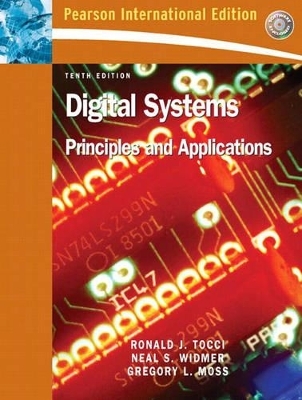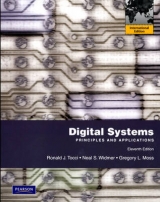
Digital Systems
Pearson
978-0-13-173969-7 (ISBN)
- Titel erscheint in neuer Auflage
- Artikel merken
For Digital Electronics or Digital Systems courses requiring a comprehensive, class and time tested text with an emphasis on the "Digital System".
Tocci: Digital Systems, hands down the most widely used textbook in Digital Electronics, uses a block diagram approach to enable students to gain a firm understanding of logic principles before they study the electrical characteristics of the logic ICs. For each new device or circuit, the authors describe the principle of the operation, give thorough examples, and then show its actual application.
Chapter 1 Introductory Concepts
1-1 Numerical Representation
1-2 Digital and Analog Systems
1-3 Digital Number Systems
1-4 Representing Binary Quantities
1-5 Digital Circuits/Logic Circuits
1-6 Parallel and Serial Transmission
1-7 Memory
1-8 Digital Computers
Chapter 2 Number Systems and Codes
2-1 Binary-to-Decimal Conversions
2-2 Decimal-to-Binary Conversions
2-3 Hexadecimal Number System
2-4 BCD Code
2-5 The Gray Code
2-6 Putting it All Together
2-7 The Byte, Nibble, and Word
2-8 Alphanumeric Codes
2-9 Parity Method for Error Detection
2-10 Applications
Chapter 3 Describing Logic Circuits
3-1 Boolean Constants and Variables
3-2 Truth Tables
3-3 OR Operation with OR Gates
3-4 AND Operation with AND Gates
3-5 NOT Operation
3-6 Describing Logic Circuits Algebraically
3-7 Evaluating Logic-Circuit Outputs
3-8 Implementing Circuits from Boolean Expressions
3-9 NOR Gates and NAND Gates
3-10 Boolean Theorems
3-11 DeMorgan7s Theorems
3-12 Universality of NAND Gates and NOR Gates
3-13 Alternate Logic-Gate Representations
3-14 Which Gate Representation to Use
3-1 5 IEEE/ANSI Standard Logic Symbols
3-16 Summary of Methods to Describe Logic Circuits
3-17 Description Languages Versus Programming Languages
3-18 Implementing Logic Circuits with PLDs
3-19 HDL Format and Syntax
3-20 Intermediate Signals
Chapter 4 Combinational Logic Circuits
4-1 Sum-of-Products Form
4-2 Simplifying Logic Circuits
4-3 Algebraic Simplification
4-4 Designing Combinational Logic Circuits
4-5 Karnaugh Map Method
4-6 Exclusive-OR and Exclusive-NOR Circuits
4-7 Parity Generator and Checker
4-8 Enable/Disable Circuits
4-9 Basic Characteristics of Digital ICs
4-10 Troubleshooting Digital Systems
4-11 Internal Digital IC Faults
4-12 External Faults
4-13 Troubleshooting Case Study
4-14 Programmable Logic Devices
4-1 5 Representing Data in HDL
4-16 Truth Tables Using HDL
4-17 Decision Control Structures in HDL
Chapter 5 Flip-Flops and Related Devices
5-1 NAND Gate Latch
5-2 NOR Gate Latch
5-3 Troubleshooting Case Study
5-4 Digital Pulses
5-5 Clock Signals and Clocked Flip-Flops
5-6 Clocked S-R Flip-Flop
5-7 Clocked J-K Flip-Flop
5-8 Clocked D Flip-Flop
5-9 D Latch (Transparent Latch)
5-10 Asynchronous Inputs
5-11 IEEE/ANSI Symbols
5-12 Flip-Flop Timing Considerations
5-13 Potential Timing Problem in FF Circuits
5-14 Flip-Flop Applications
5-15 Flip-Flop Synchronization
5-16 Detecting an Input Sequence
5-17 Data Storage and Transfer
5-18 Serial Data Transfer: Shift Registers
5-19 Frequency Division and Counting
5-20 Microcomputer Application
5-21 Schmitt-Trigger Devices
5-22 One-Shot (Monostable Multivibrator)
5-23 Clock Generator Circuits
5-24 Troubleshooting Flip-Flop Circuits
5-25 Sequential Circuits Using HDL
5-26 Edge-Triggered Devices
5-27 HDL Circuits with Multiple Components
Chapter 6 Digital Arithmetic: Operations and Circuits
6-1 Binary Addition
6-2 Representing Signed Numbers
6-3 Addition in the 2's-Complement System
6-4 Subtraction in the 2's-Complement System
6-5 Multiplication of Binary Numbers
6-6 Binary Division
6-7 BCD Addition
6-8 Hexadecimal Arithmetic
6-9 Arithmetic Circuits
6-10 Parallel Binary Adder
6-11 Design of a Full Adder
6-12 Complete Parallel Adder with Registers
6-13 Carry Propagation
6-14 Integrated-Circuit Parallel Adder
6-15 2's-Complement System
6-16 ALU Integrated Circuits
6-17 Troubleshooting Case Study
6-18 Using TTL Library Functions with Altera
6-19 Logical Operations on Bit Arrays
6-20 HDL Adders
6-2 1 Expanding the Bit Capacity of a Circuit
Chapter 7 Counters and Registers
Part 1
7-1 Asynchronous (Ripple) Counters
7-2 Propagation Delay in Ripple Counters
7-3 Synchronous (Parallel) Counters
7-4 Counters with MOD Numbers < 2N
7-5 Synchronous Down and Up/Down Counters
7-6 Presettable Counters
7-7 IC Synchronous Counters
7-8 Decoding a Counter
7-9 Analyzing Synchronous Counters
7-10 Synchronous Counter Design
7-11 Basic Counters Using HDLs
7-12 Full-Featured Counters in HDL
7-13 Writing HDL Modules Together
7-14 State Machines
Part 2
7-15 Integrated Circuit Registers
7-16 Parallel In/Parallel Out-The 74ALS174/74HC174
7-17 Serial In/Serial Out-The 74ALS166/74HC166
7-18 Parallel In/Serial Out-The 74ALS165/74HC165
7-19 Serial In/Parallel Out-The 74ALS164/74HC164
7-20 Shift-Register Counters
7-21 Troubleshooting
7-22 HDL Registers
7-23 HDL Ring Counters
7-24 HDL One-Shots
Chapter 8 Integrated-Circuit Logic Families
8-1 Digital IC Terminology
8-2 The TTL Logic Family
8-3 TTL Data Sheets
8-4 TTL Series Characteristics
8-5 Other TTL Characteristics
8-7 MOS Technology
8-8 Complementary MOS Logic
8-9 CMOS Series Characteristics
8-10 Low-Voltage Technology
8-11 Open-Collector/Open-Drain Outputs
8-12 Tristate (Three-State) Logic Outputs
8-13 High-speed Bus Interface Logic
8-14 The ECL Digital IC Family
8-15 CMOS Transmission Gate (Bilateral Switch)
8-16 IC Interfacing
8-17 Mixed-Voltage Interfacing
8-18 Analog Voltage Comparators
8-19 Troubleshooting
Chapter 9 MSI Logic Circuits
9-1 Decoders
9-2 BCD-to-7-Segment Decoder/Drivers
9-3 Liquid-Crystal Displays
9-4 Encoders
9-5 Troubleshooting
9-6 Multiplexers (Data Selectors)
9-7 Multiplexer Applications
9-8 Demultiplexers (Data Distributors)
9-9 More Troubleshooting
9-10 Magnitude Comparator
9-11 Code Converters
9-12 Data Busing
9-13 The 74ALS173/HC173 Tristate Register
9-14 Data Bus Operation
9-15 Decoders Using HDL
9-16 The HDL 7-Segment Decoder/Driver
9-17 Encoders Using HDL
9-18 HDL Multiplexers and Demultiplexers
9-19 HDL Magnitude Comparators
9-20 HDL Code Converters
Chapter 10 Digital System Projects Using HDL
10-1 Small-Project Management
10-2 Stepper Motor Driver Project
10-3 Keypad Encoder Project
10-4 Digital Clock Project
10-5 Frequency Counter Project
Chapter 11 Interfacing with the Analog World
11-1 Review of Digital Versus Analog
11-2 Digital-to-Analog Conversion
11-3 D/A-Converter Circuitry
11-4 DAC Specifications
11-5 An Integrated-Circuit DAC
11-6 DAC Applications
11-7 Troubleshooting DACs
11-8 Analog-to-Digital Conversion
11-9 Digital-Ramp ADC
11-10 Data Acquisition
11-11 Successive-Approximation ADC
11-12 Flash ADCs
11-13 Other A/D Conversion Methods
11-14 Sample-and-Hold Circuits
11-15 Multiplexing
11-16 Digital Storage Oscilloscope
11-17 Digital Signal Processing (DSP)
Chapter 12 Memory Devices
12-1 Memory Terminology
12-2 General Memory Operation
12-3 CPU-Memory Connections
12-4 Read-only Memories
12-5 ROM Architecture
12-6 ROM Timing
12-7 Types of ROMs
12-8 Flash Memory
12-9 ROM Applications
12-10 Semiconductor RAM
12-11 RAM Architecture
12-12 Static RAM (SRAM)
12-13 Dynamic RAM (DRAM)
12-14 Dynamic RAM Structure and Operation
12-15 DRAM Read/Write Cycles
12-16 DRAM Refreshing
12-17 DRAM Technology
12-18 Expanding Word Size and Capacity
12-19 Special Memory Functions
12-20 Troubleshooting RAM Systems
12-21 Testing ROM
Chapter 13 Programmable Logic Device Architectures
13-1 Digital Systems Family Tree
13-2 Fundamentals of PLD Circuitry
13-3 PLD Architectures
13-4 The GAL 16V8 (Generic Array Logic)
13-5 The Altera EPM7128S CPLD
13-6 The Altera FLEX10K Family
13-7 The Altera Cyclone Family
Glossary
Answers to Selected Problems
Index of ICs
Index
| Erscheint lt. Verlag | 16.2.2006 |
|---|---|
| Sprache | englisch |
| Maße | 211 x 275 mm |
| Gewicht | 1920 g |
| Themenwelt | Technik ► Nachrichtentechnik |
| ISBN-10 | 0-13-173969-7 / 0131739697 |
| ISBN-13 | 978-0-13-173969-7 / 9780131739697 |
| Zustand | Neuware |
| Haben Sie eine Frage zum Produkt? |
